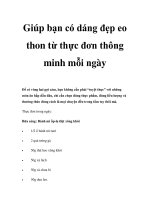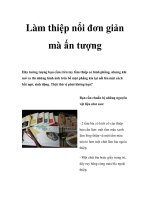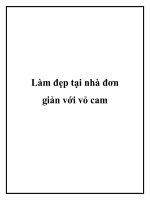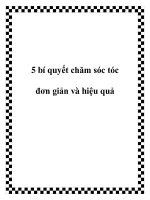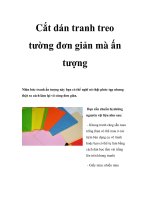Portrait Poses: Don''''t Get Locked Down! docx
Bạn đang xem bản rút gọn của tài liệu. Xem và tải ngay bản đầy đủ của tài liệu tại đây (33.57 KB, 4 trang )
Portrait Poses:
Don't Get Locked
Down!
How the subject in a portrait poses is a big part of creating a great portrait. The
rules that apply to photography can be directly transferred into this arena. The
basics for framing a subject and planning the portrait are both basically the same.
The best part about technology these days is the use of digital cameras, which
allow you to capture many pictures and review them instantly. This can be great a
tool for experimenting with different angles and poses.
When in search for ideas for shots, the best way to be inspired is to look at
other artists' work.
Many people are further ahead and just flat-out have more experience. Everyone
can learn something new from anyone of any skill level. I turn to digital cameras
or pictures that others or I have taken for interesting portrait poses.
When I have a mental block on ideas, I look to other artists' work, movie posters,
and professional photographers' photographs. They will inspire your work greatly
and more importantly give you new ideas about portraiture and how you can use
it. Sure there are the basic poses that you can look up in any book. These are the
same poses you already know. Just walk by a Glamour Shots or pull out your old
school photos and you will see examples of these.
Tip: If you are trying to create something fresh and dynamic, you will always want
to take into consideration your subject matter and its surroundings. Those two
things will impact the tone of the image more than anything.
There are a few great artists that come to mind when thinking of ground-breaking
portraits. One is Chuck Close(right). He is also one of my personal favorites. His
take on portraits is very informal but has a very big impact if not for the image
itself then the shear size of his pieces. If you have a chance to see any of his pieces
in person, I highly recommend checking them out.
Another artist that comes to mind is photographer David LaChepelle(below).
While his pieces create very elaborate worlds and some would say at times are a
little vulgar, they open up your mind to what a portrait can convey. Both of the
artists have completely different styles and mediums, yet both are very inspiring
and innovative.
Like all art, the goal is to be effective and have a focused vision that will
inspire the viewer and yourself.
A more concise vision shows your own unique style and views. While I could
have rattled off a bunch of different portrait poses to try and go through, there are
many books out there that are far more comprehension than I could go into here.
The main idea I am trying to get across here is to figure out your vision and how
you want to portray your subject, whether it is a drawing or a photograph. Then
experiment with any portrait poses that you may think are good.
No one pose is right or effective for all portraits. I would like to make it clear that
I am not saying that traditional portrait poses are not a good start, but if they do
not fully portray or realize the vision in your head, then find one that will. You are
not locked down into set guidelines when it comes to creating art. With some basic
art composition and a creative desire, you can create amazing, unique portraits.


